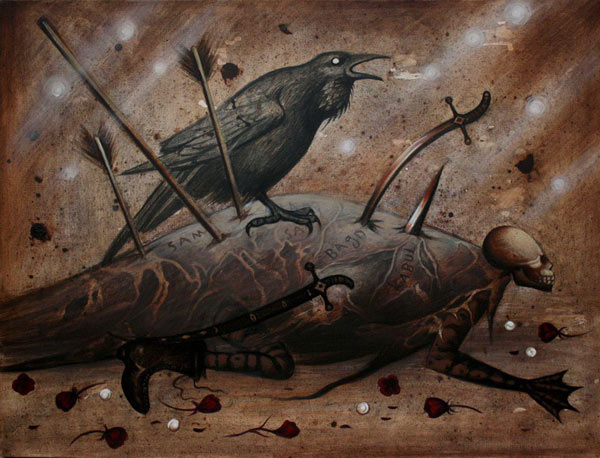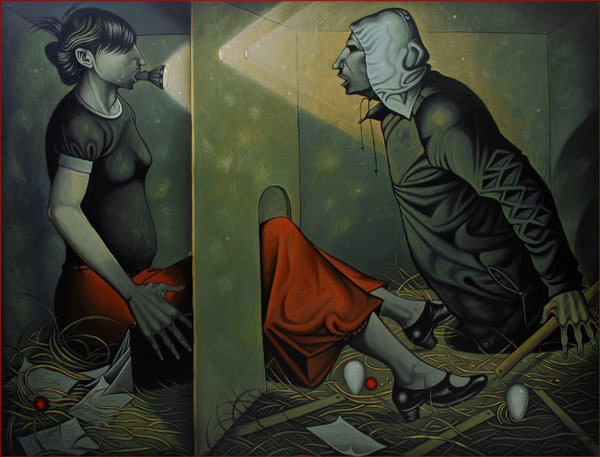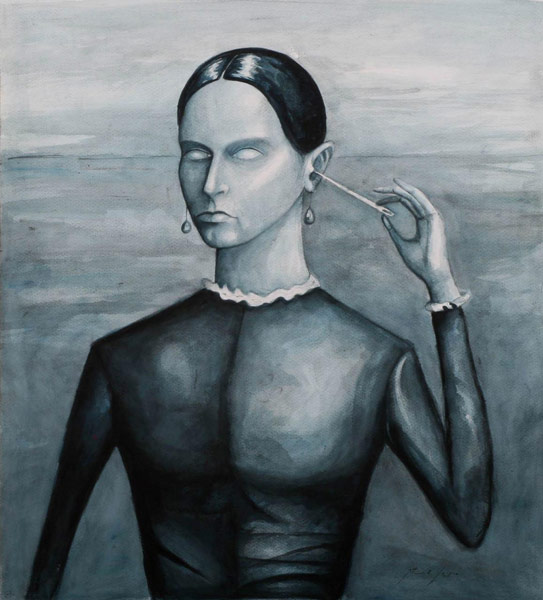Nazaar Mosavi Nia was born in 1979 Abadan, Iran. With B.A., M.A. in painting he is a young noted artist in Iran. In recent years he has flourish in domestic and international art societies, with several solo exhibitions inside and outside of Iran, he also has participated in Tehran’s auction and Christie’s auction. In a private interview with Nazaar Mosavi Nia regarding his work, we will discuss his concerns about Iranian contemporary art, historical pathology of Iran’s art, art’s economy and it’s impact on the new generation of Iranian artists.
Javid Ramezani, Tandis Website
translated by behrad sharifi
Javid Ramezani: When did you start professional painting?
I’m a war refugee from Abadan, but my professional work started in Isfahan and it was influenced by literature. I was trying to build a bridge between narration and image, which is different with illustration because these narrations were my own stories not translations from somewhere else. I was imaging my own mental narrations, they were not written and mostly they were dream, nightmare, poetry and delirium.
Javid Ramezani: Excellent, you had a distinct personal tone in your first exhibition in Day gallery. Now by passing time this personal tone has become more aggressive and offensive. This is very obvious in your professional career; my question is where was your starting point?
Post war impacts were still in me and about 15 years ago everything became serious for me. I was feeling painting style of those days were not satisfying what was happening in me. 90s and early 2000s were overflowing with formal concerns, and garnd achievement was modernism. But my concern was not about form and I wanted to speak my mind.
I was under influence by Ardeshir Mohases and in my opinion he was one of the most influential artists of his time. I was feeling close to literature, narrations and philosophy and also I have influenced by Foucault. War and life were my raw materials for painting and all started from Day Gallery.
In “memories of a chicken” series I tried to have more layers and a color palette in my works. Five years ago tried to study more about painting; most of my study was in classic area, while other artists contemporary to me were moving towards post modernism, there was a wave of conceptual art and performance. But I was thinking it’s not right to start study something from midpoint. During this time I studied the evolution of painting from gothic to classical and neo-classical and also visual experiences of western paintings.

Javid Ramezani: In between I would like to talk a little about yourself and your work, for instance comparing “memories of a chicken” with “ poisoned jungle”, you were using miniature much more in “memories of a chicken” ten years ago, whereas in case of “poisoned jungle” it has space and depth. In “memories of a chicken” you have a simple language that, these people are like chickens, you have shown their idiotic imitation and your social criticism in the form of art that is not committed to painting, which is connected to old Iranian stories of Marzbannameh, Kelileh o Demneh. But today you have studied and worked on composition, in fact it seems you are going back to look at pathology of our art.
Please explain more how this change has happened in your work. What I’m saying is that in “memories of a chicken” you were yourself, but today you have studied what has happened to you in your work?

Yes, I have studied and my achievement is the understanding that our art is fragmented and disjointed, western art is imported merchandise after that we came to believe that art is a science, a knowledge that we have to learn it. We didn’t move step by step. At first we have miniature but after arrival of western art we lost it completely. Later on Kamalolmolk started a good reconstruction and brought our art back to its absolute place. With coming of modernism once again everything were lost, Kamalolmolk’s experience was not transferred to his students, Where are they now? Maybe in a mall, but where is the experience of modernism?
I want to point at what happened that kamalolmolk’s students are in malls and some of the modernists are in international auctions and places like that, where did people born?
Where did Saqakhaneh (old Iranian painting style) come from?

Javid Ramezani: Do you think it was instructed? Because Tehran’s auction is not political, doesn’t have religious objection and also it is decorative, it is linked to everything and it’s best raw material for selling. Well, that is economy.
Yes, It was clearly instructed, all I’m saying is that if west had abstract expressionism, context necessary for reaching that point was provided prior to that. Their background was based on Da Vinci, Rembrandt and Van Gogh. They went on this path; with ending of WWII and all emerged contexts they reached to abstract expressionism. It was completely different from here that a high-ranking official was asking for something or ordering to establish certain style. As a result our contemporary art has stocked in current point. When there is no foundation you can witness all the things that has happen in past five years. This can be extended to gallery owners, customers, collectors, curators and art managers. When there is no theoretical and artistic base all these things will happen. Our artists suddenly and just for a short time will reach the peak and then they disappear. Market has become determinative.
Javid Ramezani: It is the same in west. Didn’t Warhol say everyone stays a famous just for fifteen minute?

I wish we had same kind of fame here, all art works were good with a limited time to be seen, artists were genius and next artist would have worked better than previous one. But here it’s opposite; tastes changes and market would become determinative. I think this type of art would destroy us more than ever.
In 2006 it was like a dream to me when my work was displayed in Christie’s beside great artists like Cindy Sherman, Jeff Koons, and Damien Hirst. Me, Mehdi Farhadian and Ehsae were from Middle East, I was confused for a while and I couldn’t believe my work will be auctioned beside “ For the Love of God”. All those passed, after that we had the crisis in 2007 prices were increased, oil price fell and things fell apart. At that time the question that came to my mind was that, did I grow after auction? What I’m saying is that there is no natural process, and that’s the reason for whatever is happening to our art.
Javid Ramezani: Didn’t you like to go to Christie’s and be seen?
No, I liked it, my point is that this process is defective, and this art has no foundation, our art economy has become fashionable, establishing a gallery has become fashionable, I’m asking why nobody is renting an apartment to artists and instead of rent take a painting from them? Why nobody provide resources for material and space for an artist in exchange art works. That our problem, please publish it to be seen by gallery owners, maybe it make a change for art.
Javid Ramezani: Lets go back to yourself, you were well received, your first exhibitions were sold out, you have gone to Christie’s and your work was desired by buyers but it didn’t stay that way and you have changed, why? How did you accept that risk?
As matter of fact my friends and relatives were saying you could sell your works what is your problem? Why won’t follow the same way, effortlessly and guaranteed? But I turned to study, re-painting and copying, and with that was the problem of not being seen. Notably “parrot and Merchant” series that did not received properly. But I did it and I’m still involved in study and experimenting, today I see most of those who have started with me are still the same and tomorrow also they will be the same, I don’t want this.
Javid Ramezani: When is your next exhibition and when your new series would be out?
I think my new exhibition will be by early 2017 some of my works also are in the process of checking and consideration for next auction.
Javid Ramezani: Tehran’s auction?
Yes 2017 Tehran’s auction
Javid Ramezani: How about out side of Iran?
For that matter I’m waiting for the gallery, which I’m working with, Khak gallery to complete its process.









